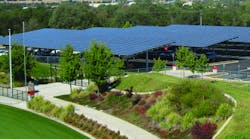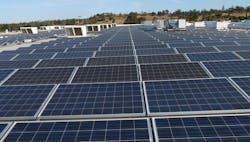The opportunities in the photovoltaic (PV) market are heating up for electrical contractors due to the declining cost of solar panels and future changes in energy regulations. While federal funding has lapsed for PV projects since the end of 2011, prospects for the solar industry still look bright, says Ralph Gentile, senior economist, McGraw-Hill Construction Research and Analytics.
In many cases, the price of PV panels has dropped to under $1 per watt at peak output, says Gentile. In turn, the gap has narrowed between the total costs of solar electricity generation, which includes capital, operating, transmission, and fossil fuel-fired plants.
“While costs for the most efficient natural gas and coal plants are lower, according to the latest Energy Information Administration calculations, changes in feedstock prices or new regulations requiring carbon capture could change the picture,” says Gentile.
Alternate energy power plant starts peaked during 2011, with solar project starts valued at nearly $22.8 billion (Chart). One of the key factors behind why this market had increased activity in 2011 was the significant uncertainty about the continuation of the investment and production tax credits, Gentile says.
In 2011, several large solar projects broke ground, including the $2.5-billion Blythe Solar Parabolic Trough Power Plant in California, the $2.2-billion Desert Sunlight Southern California Edison Solar Plant in California, and the $2-billion Solana Solar Generating Station Plant in Arizona. Currently, a large number of projects are seeking permitting in the Southwest, particularly in California, Gentile says.
“Whether these projects move forward in great number will depend upon the continuation of renewable energy mandates at the state level, since solar energy, at least for the moment, remains more expensive than conventional electricity,” he says.
The strength of the PV market in California has created new work opportunities for specialized solar installers as well as electrical contracting firms with an expertise in renewable energy. For example, Collins Electrical Co., Inc., a Stockton, Calif.-based electrical contractor, is simultaneously working on 52 sites totaling about 9.5W of capacity.
“Right now, we are going like gangbusters,” says Craig Gini, renewable general manager and vice president. “Solar is a huge market for us at this point in time.”
The contracting firm, which averages about $100 million in revenue each year, specializes in balance-of-system and turn-key installations. Due to the strength of the solar market, renewable energy now accounts for 10% to 12% of the contracting firm’s business compared to 1% to 2% just two years ago. Over the last few years, the work has shifted from the private industry sector to the public sector, Gini says.
“The [solar] industry was initially driven by rebates and incentives, and once they started to fall away, the industry began to be driven by the decrease in the pricing of solar panels,” Gini says. “This allowed the projects to still work out financially, and it gave municipalities the opportunity to install solar systems at their facilities.”
For example, Collins Electrical is currently working on 44 sites for multiple school districts throughout northern California. These installations consist of ground mount, rooftop, and carport type projects. By installing the panels on top of the carports, it not only gives the students and faculty protection from the environment, but it also helps to reduce the amount of heat generated off of the black asphalt, creating what is known as the “heat island” effect. As a result, the schools may use less air conditioning for the surrounding buildings.
The contracting firm is also starting to see quite a bit of work when it comes to utility-grade solar systems, especially in Fresno, Calif., and surrounding areas. Traditionally, these systems are about 20MW in size, but some of the mega solar installations deliver 100MW or greater.
For the utility projects, the electrical contractor typically helps to install one of two types of systems: a single-access tracker or a fixed ground mount type system. For the single-access tracker system, the electricians install one or two panels on a steel tube that rotates with the sunlight through GPS technology. This allows the panels to be exposed to about 6 hr to 7 hr of sunlight rather than 5.5 hr with the fixed-tilt type system.
While numerous advancements in technology have occurred over the last few years, the tried-and-true material has been the polycrystalline and monocrystalline modules. Other solar technologies include thin film and solar thermal, which, unlike traditional solar, use the warmth of the sun to super heat a liquid to create steam and engage a turbine to generate energy. So far, however, these types of technology have not been as prevalent as the fixed-tilt or single-axis solar systems, Gini says.
In addition to working with different types of technology, electrical contractors involved in solar projects need to be able to work on fast-track jobs. Most projects only last between a few weeks and a few months, and multiple trades work concurrently to meet the deadlines.
Right now, the contractor is working on a 60MW project with a developer, and Gini forecasts in the future, there will be a tremendous amount of work with schools and municipalities. Down the road, however, he expects the market to cool down slightly.
“I think there might be a saturation point in about four years or so,” he predicts.
In the meantime, Collins Electrical, along with other electrical contractors, is enjoying the hot opportunities in the solar market.
Fischbach is a freelance writer based in Overland Park, Kan. She can be reached at [email protected].






